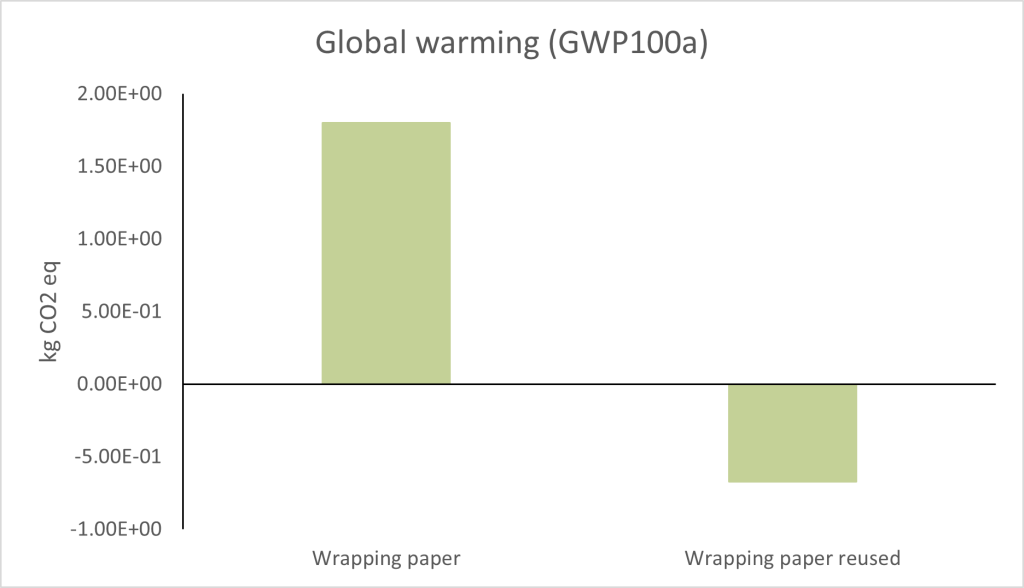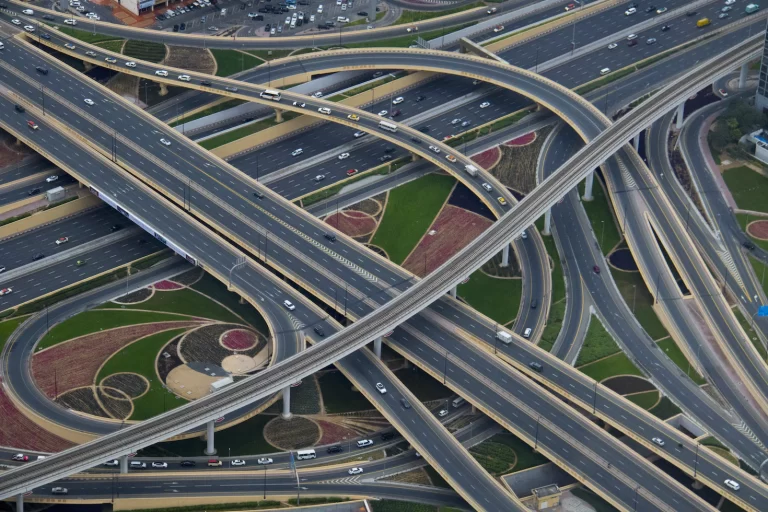The Christmas season is a significant carbon contributor, with more food consumed and wasted, more plastic packaging and increased electrical consumption. During Christmas around 30% more waste is produced. Christmas Eve, Christmas day and Boxing Day contribute just under 6% of the UKs total yearly carbon[1]. From a Suez Webinar of sustainable consumption Dr Anna Scott from Keep Britain Tidy said from research 80% of people believe ‘we’ consume/buy too much, however only 15% believe they themselves consume too much. However, there are ways we can all reduce are carbon and environmental impact and have a more sustainable season, this can be done through ways such as consuming less, and through reuse and repair of broken or unwanted items. In this blog we cover tips to reduce your carbon impact and provide a Life Cycle Assessment (LCA) of wrapping paper to illustrate the differences these changes can make.
We carried out an LCA on 2 scenarios:
- Wrapping paper bought in the store (within walking distance) and then disposed of in the general rubbish (residual waste stream). This scenario was used as this was assumed to be the way most people will dispose of their wrapping paper[2].
- Reusing wrapping paper, in this case the impacts of manufacture and freight transport are avoided. And after reusing once, the wrapping paper is ready for disposal as the scenario above.
Wrapping Paper LCA

As shown in the figure above reusing wrapping paper just once produces significantly less carbon. Using new wrapping paper contributes 1.8kg CO2 equivalent(1.80E+00 kg), whereas reusing wrapping paper contributes -0.67kg CO2 equivalent(-6.7E-01 kg). The negatives arise from the offsetting and avoidance of use of raw materials and transport. Which would otherwise have taken place if new wrapping paper were bought and used instead. This LCA shows the benefit of reusing wrapping paper and reducing your carbon emissions. In practice this would involve wrapping with very little tape and carefully unwrapping gifts so that the paper can be reused. The average UK supermarket cost ranges from around £1.50 – £4.00, with the average household using 4 rolls a year[3]. By reusing the wrapping paper where viable and practicable households could also save money. If crumpled there are ways to flatten the paper back out. If the wrapping paper is ripped reusing the paper in another way would also reduce the carbon emissions. In the section below we cover the ways to reuse wrapping paper in more detail and other tips to reduce carbon emissions this season.
Tips to reduce your carbon emissions and become more sustainable this Christmas:
Christmas trees
- Rent a Christmas tree – organisations offer Christmas trees to be collected or delivered. The trees must be cared for to be replanted when returned, for the next Christmas. Some organisations offer rent of artificial Christmas trees. Reusing artificial Christmas trees between 10 to 12 times reduces the carbon footprint over its lifetime and makes it comparable to a real tree[4][5].
- If buying a real tree, buy from local sustainable growers and find recycling drop off points for your tree or take to the HWRC and add it to green waste. Most trees in the UK market are imported, which would increase the carbon footprint of the tree, buying trees with the Forest Stewardship Council (FSC) label on ensure the tree was grown within the UK.
Wrapping
- Wrap gifts in recycled wrapping paper, or use wrapping paper which can be recycled, glossy wrapping paper which scrunches up and springs back easily cannot be recycled.
- Use scrap fabric to wrap gifts which can be used for multiple years.
- Wrap gifts without sellotape, use ribbon or wrap in ways which require very little tape to reduce plastic and preserve the wrapping paper.
- Keeping wrapping paper or Christmas cards to use the next year for gift tags is another tip to reduce waste and your carbon footprint. Reusing wrapping paper can be done through careful removal and straightening out the paper again, through methods such as covering the paper or flattening and placing under something flat and weighted. If the paper is too crinkled or ripped in some places, the wrapping paper can be used to make gift tags, be used for smaller items, or as packing to protect fragile ornaments for storage.
Decorations
- Reusable advent calendar – using an advent calendar that can be reused for years reduces the carbon impact and saves money if used multiple times. Single use advent calendars are often hard to recycle and unsustainable, with other reusable options on the market, they should be avoided where practicable.
- Use LED Christmas lights. – UK residents use £66 million of electricity on Christmas Day alone. Using LED lights can use 90% less energy than incandescent lights, by using LED lights over Christmas can contribute a significant saving [6].
- Buy plastic free crackers or buy crackers which you fill yourself to put more personal and plastic free gifts inside.
- Reuse decorations that you already own, do not use decorations once.
- Make your own tree decorations out of unwanted clothes/textiles. Step-by-step guides or video tutorials on how to make decorations can be found easily online.
There are many ways to enjoy the Christmas season while minimising the negative environmental impact it can have. From recycling and reusing wrapping paper to keeping an artificial tree for 10 years where possible can make the season more sustainable and lessen the carbon impacts. In a Suez Webinar on Strategies for Sustainable Consumption Year-Round , Sustainableish showed their ‘Crap Free Christmas Buying Guide’ with the best option is the hierarchy being Buying less, then, buy second hand, make, buy local and buy ethical. This hierarchy can not only be applied to consumption at Christmas but also all year round[7].

Merry Christmas from the Credibly Green Team!
Credibly Green provide technical advice to clients on all things carbon. See www.crediblygreen.com or call 01746 552423 or email support@crediblygreen.com
[1]Christmas Waste Facts – Tis The Season To Recycle (wastemanaged.co.uk)
[2] The Shocking Environmental Impact of Wrapping Paper | WBS (wheeliebinsolutions.co.uk) Christmas Waste Statistics – Making Christmas ‘Green’ – Wayst Blog
[3] A Guide to Reducing Christmas Wrapping Paper Waste (businesswaste.co.uk)
[6] https://hugoenergyapp.co.uk/christmas-lights-and-energy-saving/
[7] Read et al. “Strategies for Sustainable Consumption Year-Round.” Suez. 11 Dec. 2023, Online.
Strategies for sustainable consumption year-round – SUEZ in UK




